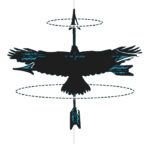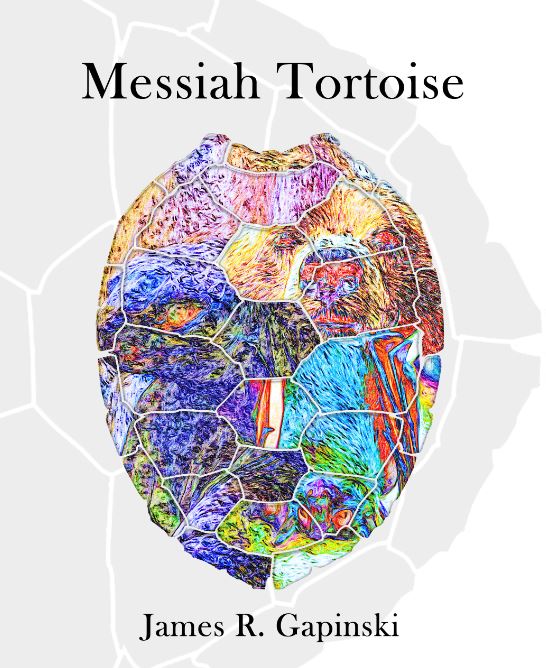 Naturally, we had a few follow-up questions about this stunner of a collection, and James was nice enough to answer them for us:
BRYCE: There are a lot of animals in this collection that are associated with various personalities, how did you deduce which animal would best be personified for specific stories? For example, why a freedom seeking chimp instead of a freedom seeking bat (and visa versa)?
GAPINSKI: In most stories, there’s more of a loose allegory than direct one-to-one relationship with the animal’s real-life characteristics. So a freedom-seeking bat could’ve been just as plausible as a chimp. I guess it mostly comes down to what I personally associate the animals with. So in the example of the bat story, I tend to think of bats as misunderstood creatures, and that bled into the story.
BRYCE: Of course, I have to ask which animals are your favorite? Any particular reason why?
GAPINSKI: If I’m thinking about the animals in my stories, I like the grizzly bear the best. I can relate to the bear’s desire to just curl up and escape from the world. If I’m thinking about my real-life encounters with animals, I love turtles and tortoises—that’s probably why I decided to make the tortoise a revered creature in this collection. I’m also a cat person. My partner and I have two housecats, and I think that tigers and other big cats are majestic and fascinating.
BRYCE: What experiences have you had with the zoo environment, either as a child or an adult? How did these experiences bleed into your creative work?
GAPINSKI: The zoo is equal parts magical and melancholic. I love animals, and I’m in awe of earth’s rich biodiversity every time I visit the zoo. I can also remember going to the zoo as a kid and enjoying every second of it without any of stress or bitterness or pessimism of adulthood. At the same time, the zoo can also be depressing. There are all these animals trapped in little cages. In some cases, captive breeding programs can help save endangered and threatened species—and some zoos keep species alive through this kind of work—but habitat destruction is still a sad reality. In my collection, I try to capture both sides of the zoo’s mystique. There are whimsical elements in this collection, but there’s also bleakness in many stories.
BRYCE: In the title story, “Messiah Tortoise”, the main character wants to believe in religion, to have that comfort. Everyone wants something to believe in something, so what do you believe in? What comforts you?
Well, as I said earlier, I like cats. I find them comforting, especially if I’ve had a particularly rough day. A cat’s purr is soothing. I also find comfort in my partner and in books. I prefer not to get into a direct dialogue about “beliefs” because that gets complicated, but the short answer is that I’m not religious.
BRYCE: Everybody on Earth strives to have money. It’s a necessity, unfortunately, to survive. In this collection it seems that the dividing variable that separates an antagonist from a protagonist is sympathy / empathy. What other variables exist that you believe divides the good people from the bad people (as far as seeking money is concerned)?
GAPINSKI: I’m not sure. I think that question is a bit above my pay grade—I’m no philosopher. I like to write stories that explore the possibilities of human nature, but I’m not one to label people good or bad. I think there are few—if any—absolutes in fiction. I don’t mean to be coy; I simply don’t have a great answer for this question. I think that writing is a way to interrogate bigger questions, but the actual answers need to come from the reader.
BRYCE: What’s next for you – what projects are you currently working on?
I have a novella coming out with Etchings Press next month. It’s called Edge of the Known Bus Line. It’s about a woman who boards the wrong bus and gets dropped off in a surreal hellscape. It’s a survivalist tale, and it’s a lot darker than Messiah Tortoise, but it still has some notes of humor too. I’ve been preoccupied with all the final revisions for that piece, reviewing proofs, talking to venues about readings, stuff like that. I feel like I’m still living in that project, and I’m not thinking ahead yet. Once the novella comes out, I’m sure I’ll dive into some short fiction again.
Check out the title story of Gapinski’s collection, “Messiah Tortoise”, as published in Pidgeonholes‘ VERDA issue, here.
Copies of MESSIAH TORTOISE can be purchased through Red Bird Chapbooks.
Naturally, we had a few follow-up questions about this stunner of a collection, and James was nice enough to answer them for us:
BRYCE: There are a lot of animals in this collection that are associated with various personalities, how did you deduce which animal would best be personified for specific stories? For example, why a freedom seeking chimp instead of a freedom seeking bat (and visa versa)?
GAPINSKI: In most stories, there’s more of a loose allegory than direct one-to-one relationship with the animal’s real-life characteristics. So a freedom-seeking bat could’ve been just as plausible as a chimp. I guess it mostly comes down to what I personally associate the animals with. So in the example of the bat story, I tend to think of bats as misunderstood creatures, and that bled into the story.
BRYCE: Of course, I have to ask which animals are your favorite? Any particular reason why?
GAPINSKI: If I’m thinking about the animals in my stories, I like the grizzly bear the best. I can relate to the bear’s desire to just curl up and escape from the world. If I’m thinking about my real-life encounters with animals, I love turtles and tortoises—that’s probably why I decided to make the tortoise a revered creature in this collection. I’m also a cat person. My partner and I have two housecats, and I think that tigers and other big cats are majestic and fascinating.
BRYCE: What experiences have you had with the zoo environment, either as a child or an adult? How did these experiences bleed into your creative work?
GAPINSKI: The zoo is equal parts magical and melancholic. I love animals, and I’m in awe of earth’s rich biodiversity every time I visit the zoo. I can also remember going to the zoo as a kid and enjoying every second of it without any of stress or bitterness or pessimism of adulthood. At the same time, the zoo can also be depressing. There are all these animals trapped in little cages. In some cases, captive breeding programs can help save endangered and threatened species—and some zoos keep species alive through this kind of work—but habitat destruction is still a sad reality. In my collection, I try to capture both sides of the zoo’s mystique. There are whimsical elements in this collection, but there’s also bleakness in many stories.
BRYCE: In the title story, “Messiah Tortoise”, the main character wants to believe in religion, to have that comfort. Everyone wants something to believe in something, so what do you believe in? What comforts you?
Well, as I said earlier, I like cats. I find them comforting, especially if I’ve had a particularly rough day. A cat’s purr is soothing. I also find comfort in my partner and in books. I prefer not to get into a direct dialogue about “beliefs” because that gets complicated, but the short answer is that I’m not religious.
BRYCE: Everybody on Earth strives to have money. It’s a necessity, unfortunately, to survive. In this collection it seems that the dividing variable that separates an antagonist from a protagonist is sympathy / empathy. What other variables exist that you believe divides the good people from the bad people (as far as seeking money is concerned)?
GAPINSKI: I’m not sure. I think that question is a bit above my pay grade—I’m no philosopher. I like to write stories that explore the possibilities of human nature, but I’m not one to label people good or bad. I think there are few—if any—absolutes in fiction. I don’t mean to be coy; I simply don’t have a great answer for this question. I think that writing is a way to interrogate bigger questions, but the actual answers need to come from the reader.
BRYCE: What’s next for you – what projects are you currently working on?
I have a novella coming out with Etchings Press next month. It’s called Edge of the Known Bus Line. It’s about a woman who boards the wrong bus and gets dropped off in a surreal hellscape. It’s a survivalist tale, and it’s a lot darker than Messiah Tortoise, but it still has some notes of humor too. I’ve been preoccupied with all the final revisions for that piece, reviewing proofs, talking to venues about readings, stuff like that. I feel like I’m still living in that project, and I’m not thinking ahead yet. Once the novella comes out, I’m sure I’ll dive into some short fiction again.
Check out the title story of Gapinski’s collection, “Messiah Tortoise”, as published in Pidgeonholes‘ VERDA issue, here.
Copies of MESSIAH TORTOISE can be purchased through Red Bird Chapbooks.
